Germany
Development challenges as investment and business opportunities: Germany’s policy and practices
Germany uses public development finance to leverage engagement and investment from the private sector for sustainable development, seeking to build synergies among the various German stakeholders at home and in partner countries (OECD, 2015). It mobilises a wide range of instruments as part of its financial co-operation – from concessional loans to risk capital provision and guarantees – which are extended by KfW, Germany’s development finance institution. In its financial (KfW) and technical co-operation (GIZ) activities, Germany has also developed some innovative approaches for engaging with developing country, German and international companies. For example, Germany has set up a “Trade Policy and Trade Promotion Fund” that aims at building the capacities of partner country decision makers and non-state actors to develop and implement coherent and comprehensive strategies for the promotion of trade and investment. In addition, the fund promotes the cross-linkage of state and non-state stakeholders so that they can jointly develop and implement trade strategies.
Deutsche Investitions – und Entwicklungsgesellschaft (DEG), a subsidiary of the KfW, is dedicated to promoting business initiatives in developing and emerging economies by financing operations and providing advisory services.
According to the 2015 DAC Survey on Mobilisation (Benn et al., 2016), Germany mobilised USD 251 million from the private sector through the KfW’s guarantees and shares in collective investment vehicles in 2012-14. Credit lines were also very important over the same period, although they were not covered by the survey.
Financial flows from Germany to developing countries
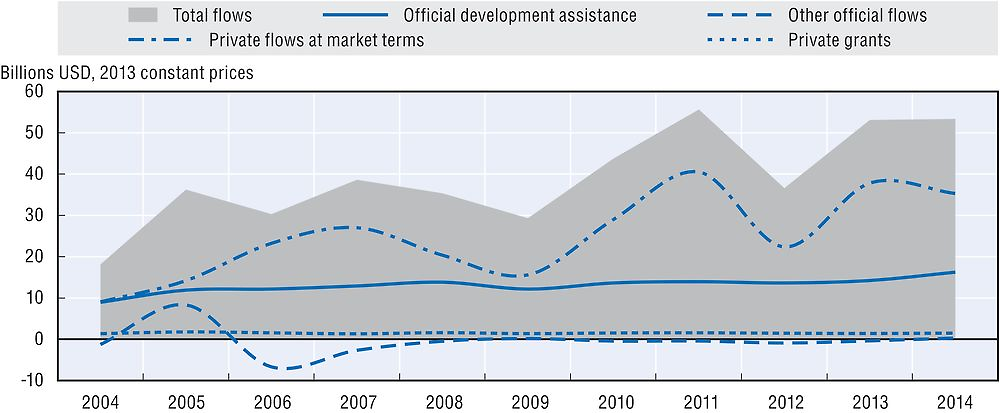
Germany uses ODA to mobilise other resources for sustainable development
-
Germany contributes to the mobilisation of domestic resources in developing countries by supporting their tax systems. In 2014, it is estimated that Germany committed USD 276 000 of its official development assistance (ODA) to tax-related activities in partner countries.
-
It promotes aid for trade to improve developing countries’ trade performance and integration into the world economy. It committed USD 7.7 billion to trade-related activities in 2014 (49.4% of its sector-allocable ODA), a 50.6% increase in real terms from 2013. The trend has been increasing over the past few years.
-
Germany has pledged USD 1 billion (EUR 750 million) to the Green Climate Fund, which plays a key role in channelling resources to developing countries and catalysing climate finance at the international and national levels. In 2015/16, Germany will also contribute a total amount of USD 53 million (EUR 50 million) to the Least Developed Countries Fund, which addresses urgent and immediate adaptation needs and supports national adaptation planning processes to reduce medium and long-term vulnerability to the impacts of climate change.
Germany’s official development assistance
In 2015, Germany provided USD 17.8 billion in net ODA (preliminary data). This represented 0.52% of gross national income (GNI) and a 25.9% increase in real terms from 2014, due mostly to an increase in-donor refugee costs. Germany is the ninth largest Development Assistance Committee (DAC) provider in terms of ODA as a percentage of GNI, and the third largest in terms of volume. Germany’s ODA reached a record high in 2015 and is set to continue to rise up to 2019. Like other EU member countries, it is committed to meeting the 0.7% ODA/GNI target by 2030.
Germany’s share of untied ODA (excluding administrative costs and in-donor refugee costs) was 83.6% in 2014 (up from 80.1% in 2013), compared to the DAC average of 80.6%. The grant element of total ODA was 83.6% in 2014 (decreasing from 86.9% in 2013 and 88.4% in 2012), below the DAC compliance grant element norm of 86%.
Germany reported USD 171.4 million of its in-donor refugee costs as ODA in 2014. These costs represented 1% of its total net ODA.
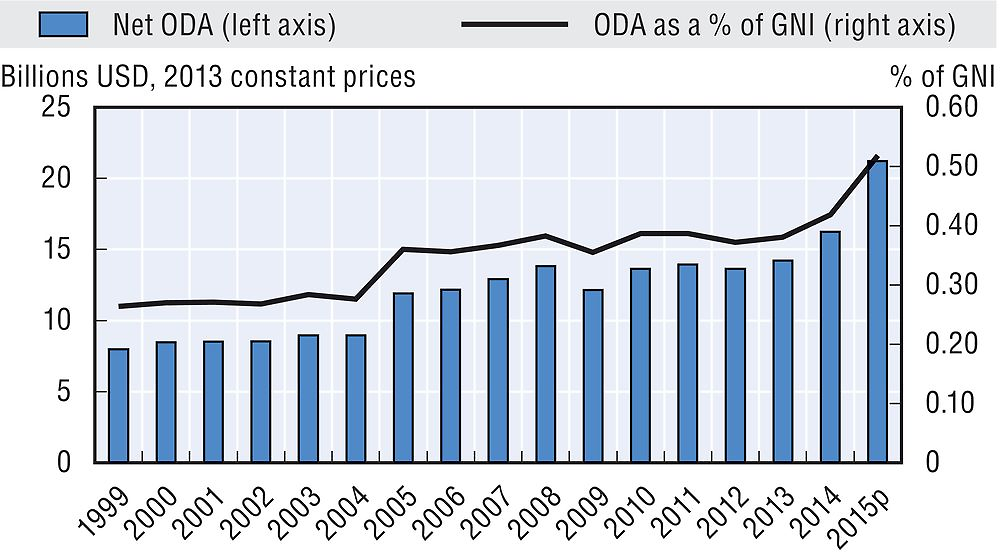
In 2014, 74.3% of ODA was provided bilaterally. Germany allocated 25.7% of total ODA as core contributions to multilateral organisations, compared with the DAC country average of 28.3%. In addition, it channelled 6.2% of its bilateral ODA for specific projects implemented by multilateral organisations (multi-bi/non-core contributions).
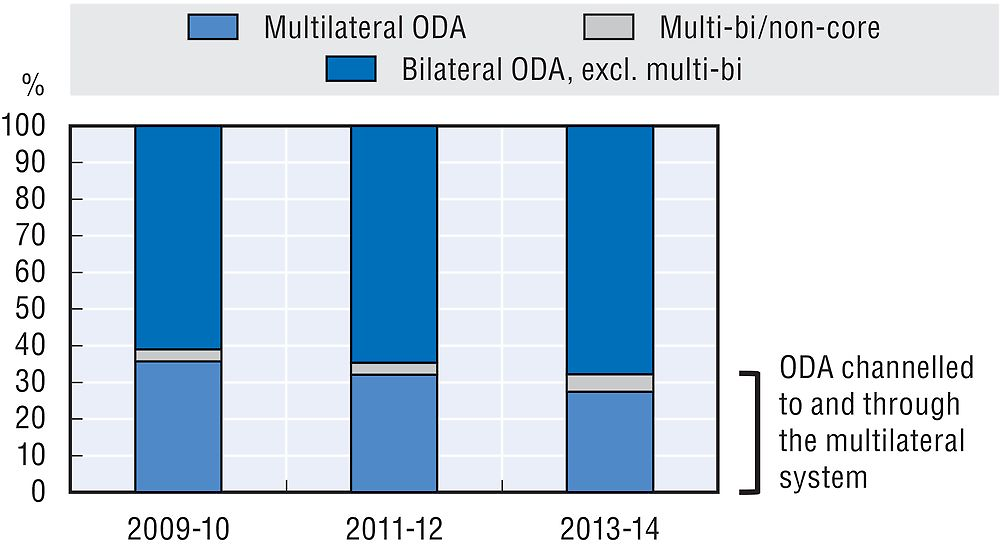
In 2014, 53.4% of bilateral ODA was programmed at partner country level. Germany’s share of country programmable aid (CPA) was slightly above the DAC country average (52.9%) in 2014. Project-type interventions accounted for 82% of CPA.
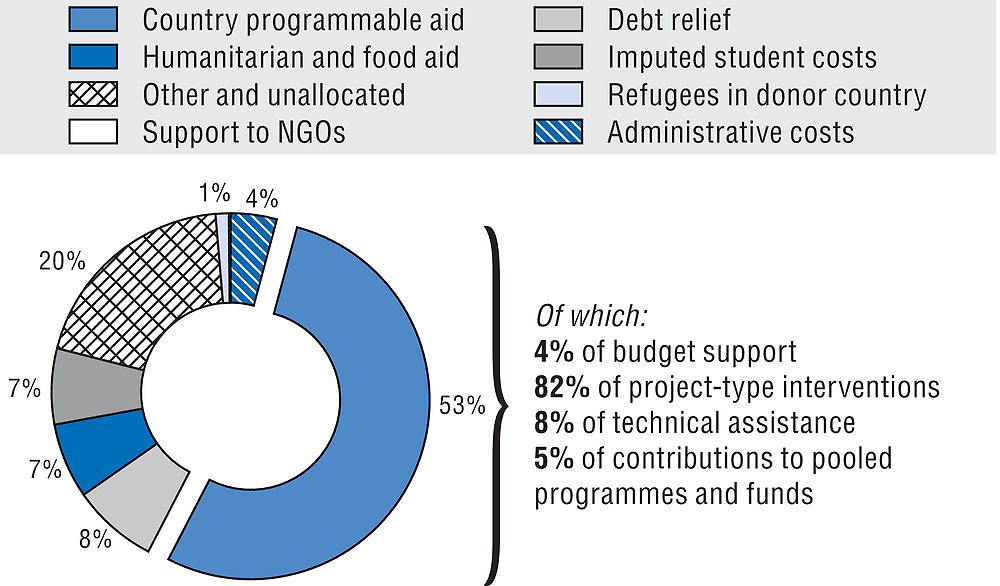
In 2014, USD 1.2 billion of bilateral ODA was channelled through civil society organisations (CSOs), corresponding to 8.2% of bilateral aid, compared with the DAC country average of 17.4%. Between 2013 and 2014, ODA through CSOs increased in terms of volume (+4.2%), but decreased as a share of bilateral ODA (it was 9.7% in 2013).
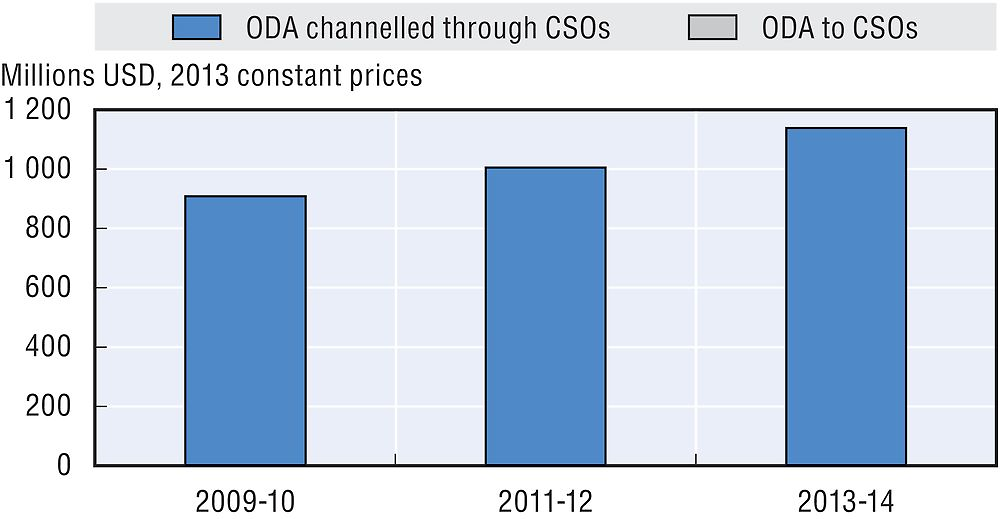
Note: Data on ODA to civil society organisations are not available.
Bilateral ODA primarily focused on south and central Asia and sub-Saharan Africa. In 2014, USD 3 billion was allocated to south and central Asia, and USD 2 billion was allocated to sub-Saharan Africa.
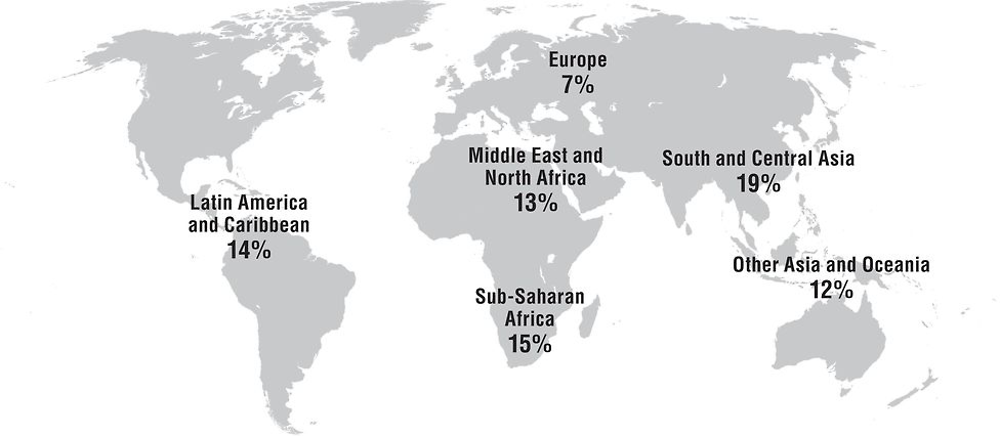
Note: 19% of bilateral ODA allocated was unspecified by region in 2013-14. This share is not represented on the map.
In 2014, 37.4% of bilateral ODA went to Germany’s top 10 recipients. Germany has bilateral programmes with 50 partner countries. It co-operates with another 29 countries on thematic issues. The 2015 DAC Peer Review of Germany found that there has been an increase in German funds which are not allocated geographically, which would explain a relatively low concentration of its aid by country. In 2014, its support to fragile states reached USD 3.8 billion (26.8% of gross bilateral ODA).
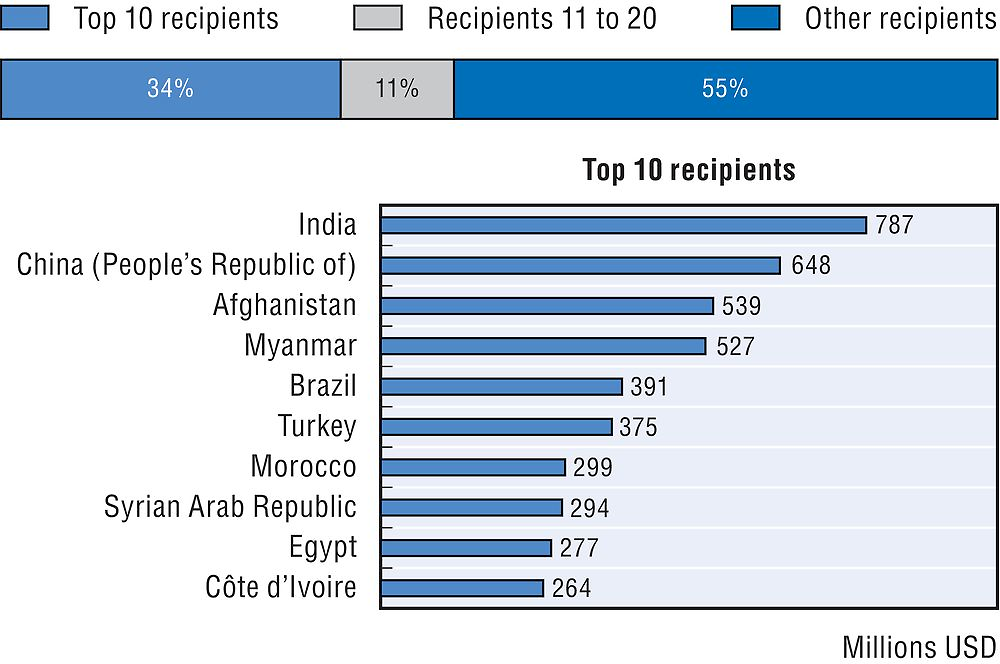
In 2014, 20.6% of bilateral ODA was allocated to least developed countries (LDCs), amounting to USD 3 billion. This is an increase from 15.8% in 2013 but is still lower than the 2014 DAC average (25.6%). In 2014, upper middle-income countries received the highest share of bilateral ODA (24.6%) compared with other income groups.
At 0.10% of GNI in 2014, total ODA to LDCs was lower than the UN target of 0.15% of GNI.
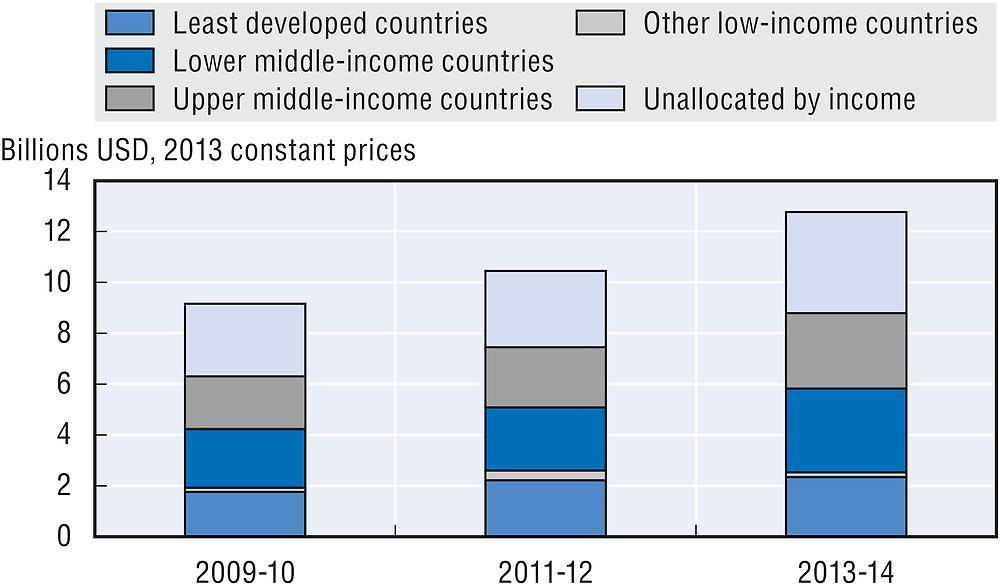
In 2014, 36.1% of Germany’s bilateral ODA was allocated to economic infrastructure and services, amounting to USD 6.5 billion, with a strong focus on energy generation and supply (USD 3.9 billion). USD 5.9 billion was allocated to social infrastructure and services, with a focus on support to education (USD 2.1 billion) and government and civil society (USD 2 billion).

USD 5.9 billion of bilateral ODA supported gender equality in 2014. The BMZ integrates gender equality into programming through political dialogue, empowerment and gender mainstreaming. According to the 2015 DAC Peer Review, Germany should match its commitment to gender equality with adequate leadership, resources and tools. In 2014, 39% of German bilateral allocable aid had gender equality and women’s empowerment as a principal or significant objective, compared with 41.5% in 2013 and 44.7% in 2009. The DAC country average was 34.7% in 2014. Germany’s aid to population and reproductive health and other social infrastructure focuses on gender.
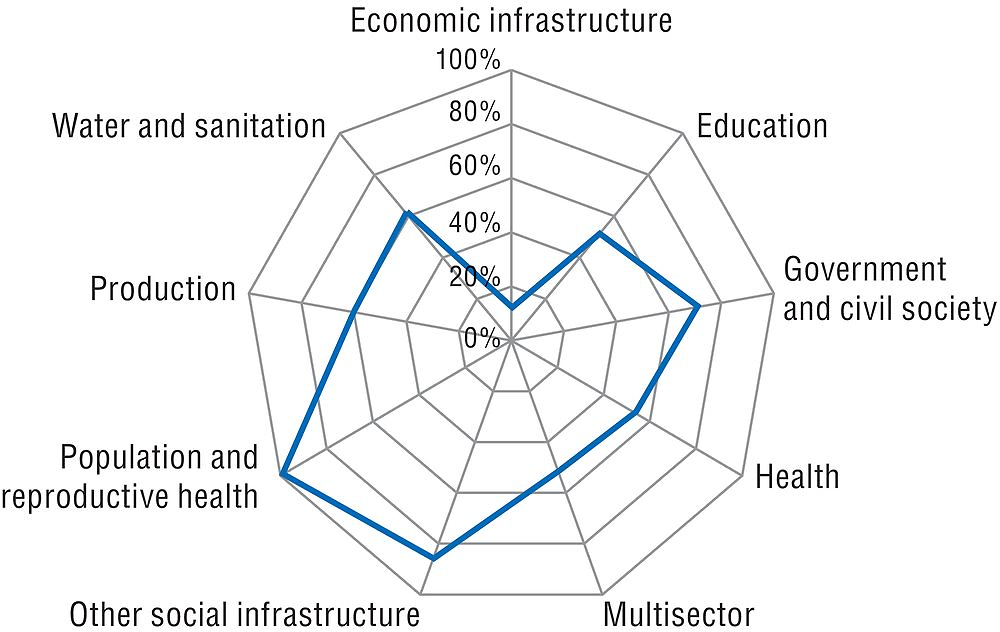
USD 8.5 billion of bilateral ODA supported the environment in 2014. Climate change is well embedded in the programme along with the environment and natural resource issues (OECD, 2015). Germany helps partner countries to identify the causes of environmental and climate risks, strengthen their governance structures and policies, and develop regional co-operation. Capacity building and technology transfer are key components of Germany’s support (ibid.). In 2014, the share of German bilateral allocable aid focusing on the environment reached 54.8%, compared to the DAC country average of 32.2%. Germany’s financial commitment to climate change mitigation has steadily increased in recent years. Its share of bilateral allocable aid reached 46.9% in 2014 (USD 7.3 billion), compared to the DAC country average of 23.9%.
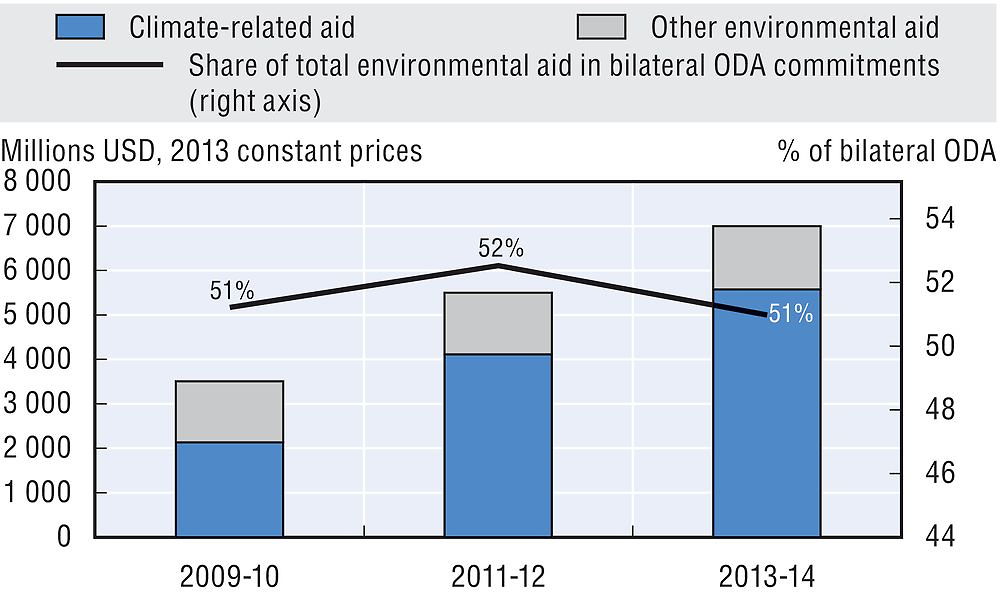
Note to reader: Annex B provides “Methodological notes on definitions and measurement for the Profiles of Development Assistance Committee members”.
Reference
OECD (2015), OECD Development Co-operation Peer Reviews: Germany 2015, OECD Development Co-operation Peer Reviews, OECD Publishing, Paris, https://doi.org/10.1787/9789264246133-en.
